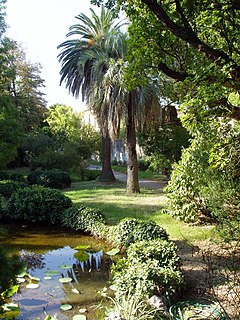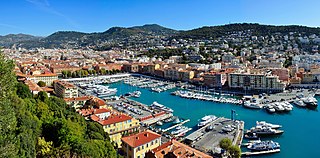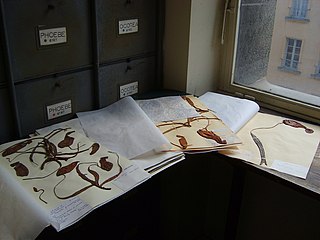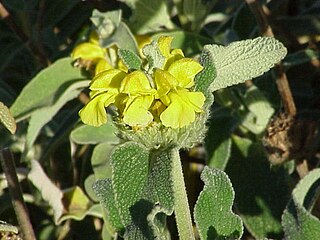
The Espace Pierres Folles is a museum with geological exhibit and botanical garden located at 116 chemin du Pinay, St Jean des Vignes, Rhône, Rhône Alpes Auvergne, France. It is open daily in the warmer months; an admission fee is charged.

The Jardin botanique de la Villa Thuret is a renowned botanical garden located on the grounds of the Villa Thuret, 90, chemin Raymond, Antibes Juan-les-Pins, Alpes-Maritimes, Provence-Alpes-Côte d'Azur, France. It is open weekdays without charge.

The Jardin botanique exotique de Menton, also known as the Jardin botanique exotique du Val Rahmeh, is a botanical garden located off Avenue St Jacques, Menton, Alpes-Maritimes, Provence-Alpes-Côte d'Azur, France. It is open daily except Tuesday; an admission fee is charged.

The Jardin botanique E.M. Heckel, also known as the Jardin botanique de Marseille and the Jardin botanique Borély de Marseille, is a municipal botanical garden in the Parc Borély at 48, Avenue Clot Bey, Marseille, Bouches-du-Rhône, Provence-Alpes-Côte d'Azur, France. It is open daily except Monday; an admission fee is charged.

The Jardin botanique de l'Arquebuse is a botanical garden and arboretum located at 1 Avenue Albert-Premier, Dijon, Côte-d'Or, Bourgogne, France. It is open daily without charge.

The Jardin botanique de Besançon, more formally the Jardin botanique de l'Université de Franche-Comté et de la Ville de Besançon, is a botanical garden located on the Place du Maréchal Leclerc, Besançon, Doubs, Franche-Comté, France. It is operated by the University of Franche-Comté and open daily; admission is free.

The Jardin botanique de Bordeaux is a municipal botanical garden located at Place Bardineau, Bordeaux, Gironde, Aquitaine, France; it is open daily without charge. This historic garden has been recently supplemented by the Jardin botanique de la Bastide, located across the river.

The Jardin botanique Henri Gaussen is a botanical garden operated by the Université Paul Sabatier at 39 allées Jules Guesde, Toulouse, Haute-Garonne, Midi-Pyrénées, France. It is open weekdays in the warmer months.

The jardin des plantes de Montpellier is a historic botanical garden and arboretum located on Boulevard Henri IV, Montpellier, Hérault, Languedoc-Roussillon, France. It is maintained by the Université Montpellier 1 and open afternoons daily except Monday; admission is free.
The Jardin botanique de la Faculté de Pharmacie d'Angers is a botanical garden and arboretum operated by the Faculty of Pharmacy of the University of Angers. It is located at 16 Boulevard Daviers, Angers, Maine-et-Loire, Pays de la Loire, France, and open weekdays without charge.
The Jardin botanique Yves Rocher de La Gacilly, sometimes called simply the Jardin botanique de La Gacilly, is a botanical garden located at the Yves Rocher industrial site at La Croix des Archers, La Gacilly, Morbihan, Bretagne, France. It is open daily in the warm months; admission is free.
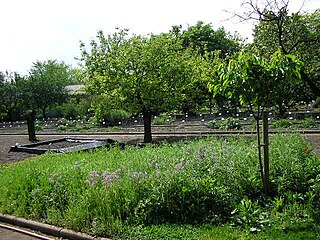
The Jardin botanique de la Charme, formerly known as the Jardin botanique de la Ville de Clermont-Ferrand, is a municipal botanical garden located at 10, rue de la Charme, Clermont-Ferrand, Puy-de-Dôme, Auvergne, France. It is open weekdays year-round plus weekends in the warmer months; admission is free.

The Jardin botanique de Lyon, also known as the Jardin botanique du Parc de la Tête d'Or, is an 8 hectares municipal botanical garden located in the Parc de la Tête d'Or, Lyon, Rhône, Rhône-Alpes, France. It is open weekdays without charge.

The Domaine du Rayol, also known as the Jardin botanique du Rayol and the Parc botanique à Rayol-Canadel-sur-Mer, is a botanical garden and arboretum located on the Avenue des Belges, Rayol-Canadel-sur-Mer, Var, Provence-Alpes-Côte d'Azur, France. It is listed as a Jardin Remarquable by the Committee of Parks and Gardens of the Ministry of Culture of France. It is open to the public, with an admission fee.
The Jardin d'Oiseaux Tropicaux is an aviary and botanical garden located on the Route de Valcros, La Londe-les-Maures, Var, Provence-Alpes-Côte d'Azur, France. It is open daily; an admission fee is charged.
The Jardin des Olfacties is a botanical garden specializing in scented plants. It is located at the Place de l'Église, Coëx, Vendée, Pays de la Loire, France, and open daily in the warmer months; an admission fee is charged.
The Jardin botanique de Gondremer is a private botanical garden with national collections of rhododendrons and azaleas, kalmia, heathers, and Japanese maples, classified as a Jardin Remarquable by the French ministry of culture. It is located several kilometers east of Autrey and Housseras, Vosges, Grand Est, France, and open at specific periods suitable for the collections; an admission fee is charged.

Bénédict Pierre Georges Hochreutiner (1873-1959) was a Swiss botanist and plant taxonomist.

The Conservatory and Botanical Garden of the city of Geneva is a museum and an institution of the City of Geneva.
René Verriet de Litardière was a French botanist.
